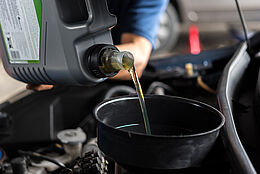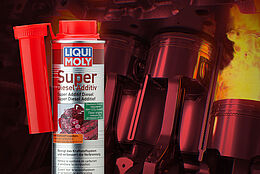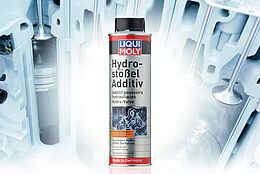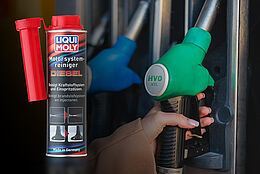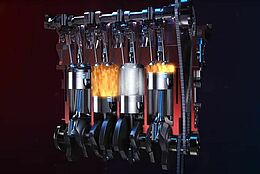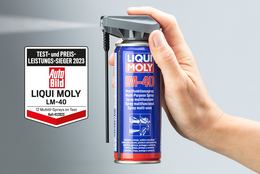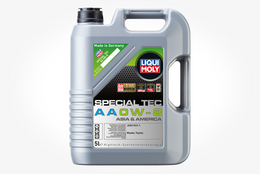- 9min
Brake fluid: Function, changing and differences

Most importantly: Brake fluids are safety-critical components! The specifications of the respective manufacturer must be strictly observed and complied with. Within the framework of the manufacturer’s instructions with regard to brake fluids, the possibilities for variations in brake fluids are rather limited.
What is brake fluid and what are its tasks?
The brake fluid is a special mixture used in hydraulic brake systems. It plays an important role in road safety. When the brake pedal is depressed, the pressure is transmitted via the brake fluid to the brake cylinders on the brake caliper. These then press the brake pads against the brake disks or drums. This reduces the speed of the vehicle.
The brake fluid must withstand extreme conditions. These include high temperatures and pressures.
Ten facts about brake fluids
- A high boiling point for safety under extreme operating conditions so that the brake fluid does not start to boil prematurely and reduce the braking effect due to the formation of steam bubbles.
- The so-called boiling point depression caused by the absorption of water into the brake fluid must be kept as low as possible; the main parameter is referred to as the wet boiling point.
- The brake fluid should also ensure corrosion protection. However, because brake fluid also has the property of absorbing water (“hygroscopic effect”), operational reliability is limited to only a certain period of time. Another argument in favor of strictly complying with the manufacturer’s specifications for changing the brake fluids.
- Brake fluid should contribute to optimum lubrication of the entire brake system and thus also protect mechanically stressed components in the brake system from wear.
- It is very important for brake fluids to be completely compatible with all system materials, e.g. with various metals as well as with all installed rubber and plastic materials.
- Brake fluids must not come into contact with paint due to their dissolving effect.
- Brake fluids are based on polyglycol ether, boric acid ester and polyglycols in varying proportions. Silicone-based brake fluids are an exception.
- Brake fluid also contains necessary additives that protect surfaces and products.
- Performance classes and specifications are essentially defined by the following standards institutes:
- FMVSS = Federal Motor Vehicle Safety Standard, DOT = Department of Transportation (USA standards)
- ISO 4925 Class X = International Organization for Standardization (European standards)
- JIS K 2233 Class X = Japanese Industrial Standard (Japanese standards)
- Important factors of all brake fluids are the dry boiling point (or also the boiling point, abbreviated to DBP or just BP) and the wet boiling point (WBP). This determines the temperature at which steam bubbles are formed. The boiling point or dry boiling point (BP) is measured for brake fluids in absolutely new condition and thus without any entrainments such as water (or other influences). The wet boiling point (WBP) is measured with water ingress. Depending on the brake fluid class, the water content for determining the WBP is between 3.2 and 4.0 percent. The requirements for technical data of the respective performance class of a brake fluid are minimum requirements and can be far exceeded depending on the manufacturer’s quality.
Why and how often do brake fluids have to be changed?
Brake fluids attract water-attracting (hygroscopic). This means that they absorb water from the ambient air over time. This can cause problems and become dangerous. When the brake fluid contains water and heats up, the water can evaporate and small steam bubbles can form in the brake system. These steam bubbles are compressible. This means that they can no longer efficiently transfer the hydraulic pressure of the brake pedal. The result is a spongy feeling when braking and reduced braking performance.
Another problem can be caused by contaminated or outdated brake fluid, which loses its protective properties. This can promote corrosion within the entire brake system and result in expensive repairs.

It is therefore important to check brake fluids regularly and to replace them at the intervals specified by the vehicle manufacturer. As a rule of thumb: The brake fluid should be changed every two years. If a problem with the braking performance is noticed, the brake fluid and the entire brake system should be checked immediately.
When changing, it is also important to use the correct brake fluid. Your LIQUI MOLY partner workshop will be happy to take care of this.
Differences in brake fluids
Brake Fluid DOT 3: Has a lower boiling point compared to higher quality types such as DOT 4 and DOT 5.1. This makes it more susceptible to steam bubble formation under high loads. It is suitable for older vehicles without modern brake control systems such as ABS or ESC. The brake fluid filler cap on modern Tesla models, for example, bears the marking “DOT 3”. This is the minimum requirement and does not mean that only DOT 3 brake fluid should be used here.
Brake Fluid DOT 4: This brake fluid is suitable for use in all disk and drum brake systems and, depending on the system/manufacturer’s specifications, also in clutch systems of motor vehicles for which a synthetic brake fluid of this specification is prescribed. The brake fluid is also suitable for use in ABS brake systems. It generally has a higher dry (DBP) and wet boiling point (WBP) compared to DOT 3.
Brake Fluid SL6 DOT 4: Developed for modern vehicles with brake systems such as ABS and ESC. Its low viscosity ensures a fast and precise response of the brake system, especially in cold weather.
Brake Fluid DOT 5: A silicone oil-based brake fluid (originally developed for military purposes) that is not hygroscopic, i.e. does not absorb moisture. It is particularly suitable for vintage cars or classic motorcycles such as some Harley-Davidson models, but not for vehicles operated with DOT 3, DOT 4 or DOT 5.1. It should never be mixed with DOT 3, DOT 4 or DOT 5.1 brake fluids.
Brake Fluid DOT 5.1: Offers fast response times due to its low viscosity, ideal for modern brake control systems such as ABS and ESC. It is characterized by high thermal stability and reliably protects against corrosion, which promotes the service life of the brake system.
Brake Fluid DOT 5.1 EV: Specially developed for electric vehicles, this brake fluid offers high thermal stability and is designed for the special requirements of electric drive technology. The brake fluid with low electrical conductivity has excellent wet and dry boiling points, which ensures safe braking even after a certain amount of moisture has been absorbed over a longer period of use. It supports electric brake systems and ensures maximum safety.
- Brake Fluid Class 7: Covers all applications previously fulfilled by two different products (DOT 4 SL6 and DOT 5.1). It exceeds conventional brake fluids according to FMVSS (Federal Motor Vehicle Safety Standards) No. 116 DOT 3, DOT 4. Brake fluid according to ISO 4925 Class 7 is our Brake Fluid DOT 5.1 EV.
Where does the term “DOT” come from?
Originally, the USA started to standardize brake fluids. Initially designed for the requirements of the military, they were introduced under the designation “DOT”, “Department of Transportation”.
What distinguishes our brake fluids?
Our brake fluids are designed to provide both a long service life and maximum safety. They protect the brake system against corrosion, care for all seals, prevent the formation of steam bubbles and maintain their performance even at extreme temperatures. Another advantage is that we are constantly advancing our products and keeping them up to date with the latest technology, in order to meet the increasing requirements of modern vehicles.
Which brake fluid is the right one for my vehicle? Use our oil guide to find the right brake fluid and other suitable operating fluids for every vehicle.
Summary
Choosing the right brake fluid and changing it regularly is crucial for the safety of the vehicle. With our brake fluids, you are ideally equipped to prevent problems such as brake failure and corrosion inside the brake system. Ensure regular maintenance and choose the brake fluid that best suits your vehicle and your driving habits.



